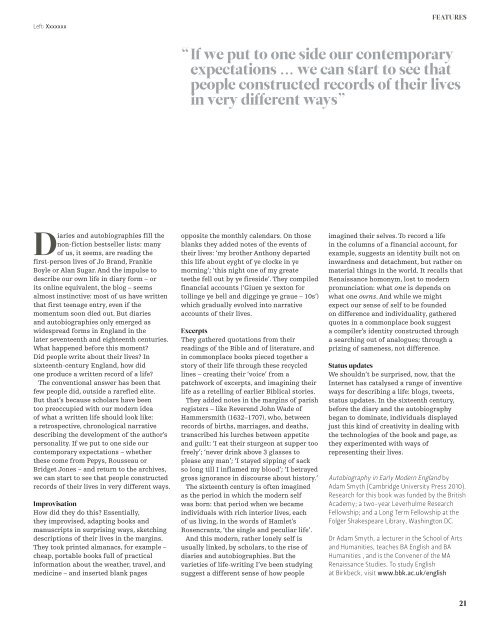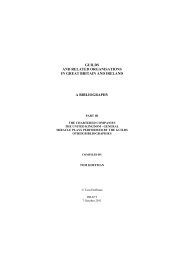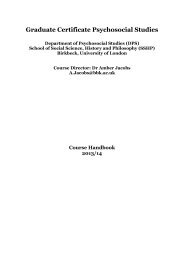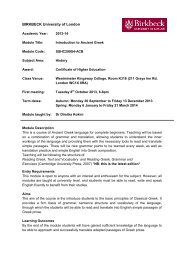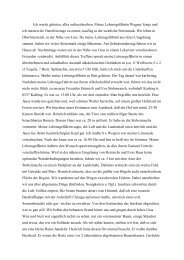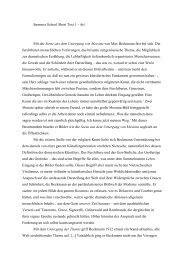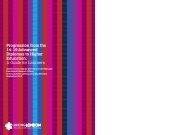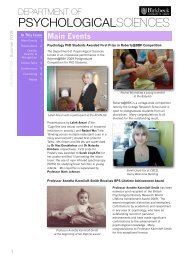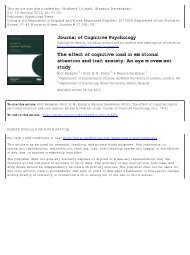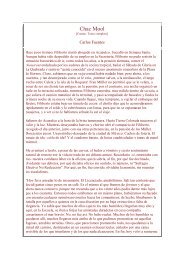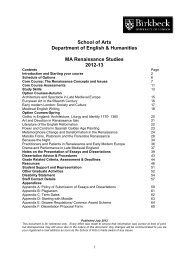Spring 2011 - Birkbeck College
Spring 2011 - Birkbeck College
Spring 2011 - Birkbeck College
You also want an ePaper? Increase the reach of your titles
YUMPU automatically turns print PDFs into web optimized ePapers that Google loves.
Left: Xxxxxxx<br />
Diaries and autobiographies fill the<br />
non-fiction bestseller lists: many<br />
of us, it seems, are reading the<br />
first-person lives of Jo Brand, Frankie<br />
Boyle or Alan Sugar. And the impulse to<br />
describe our own life in diary form – or<br />
its online equivalent, the blog – seems<br />
almost instinctive: most of us have written<br />
that first teenage entry, even if the<br />
momentum soon died out. But diaries<br />
and autobiographies only emerged as<br />
widespread forms in England in the<br />
later seventeenth and eighteenth centuries.<br />
What happened before this moment?<br />
Did people write about their lives? In<br />
sixteenth-century England, how did<br />
one produce a written record of a life?<br />
The conventional answer has been that<br />
few people did, outside a rarefied elite.<br />
But that’s because scholars have been<br />
too preoccupied with our modern idea<br />
of what a written life should look like:<br />
a retrospective, chronological narrative<br />
describing the development of the author’s<br />
personality. If we put to one side our<br />
contemporary expectations – whether<br />
these come from Pepys, Rousseau or<br />
Bridget Jones – and return to the archives,<br />
we can start to see that people constructed<br />
records of their lives in very different ways.<br />
Improvisation<br />
How did they do this? Essentially,<br />
they improvised, adapting books and<br />
manuscripts in surprising ways, sketching<br />
descriptions of their lives in the margins.<br />
They took printed almanacs, for example –<br />
cheap, portable books full of practical<br />
information about the weather, travel, and<br />
medicine – and inserted blank pages<br />
opposite the monthly calendars. On those<br />
blanks they added notes of the events of<br />
their lives: ‘my brother Anthony departed<br />
this life about eyght of ye clocke in ye<br />
morning’; ‘this night one of my greate<br />
teethe fell out by ye fireside’. They compiled<br />
financial accounts (‘Giuen ye sexton for<br />
tollinge ye bell and digginge ye graue – 10s’)<br />
which gradually evolved into narrative<br />
accounts of their lives.<br />
Excerpts<br />
They gathered quotations from their<br />
readings of the Bible and of literature, and<br />
in commonplace books pieced together a<br />
story of their life through these recycled<br />
lines – creating their ‘voice’ from a<br />
patchwork of excerpts, and imagining their<br />
life as a retelling of earlier Biblical stories.<br />
They added notes in the margins of parish<br />
registers – like Reverend John Wade of<br />
Hammersmith (1632–1707), who, between<br />
records of births, marriages, and deaths,<br />
transcribed his lurches between appetite<br />
and guilt: ‘I eat their sturgeon at supper too<br />
freely’; ‘never drink above 3 glasses to<br />
please any man’; ‘I stayed sipping of sack<br />
so long till I inflamed my blood’; ‘I betrayed<br />
gross ignorance in discourse about history.’<br />
The sixteenth century is often imagined<br />
as the period in which the modern self<br />
was born: that period when we became<br />
individuals with rich interior lives, each<br />
of us living, in the words of Hamlet’s<br />
Rosencrantz, ‘the single and peculiar life’.<br />
And this modern, rather lonely self is<br />
usually linked, by scholars, to the rise of<br />
diaries and autobiographies. But the<br />
varieties of life-writing I’ve been studying<br />
suggest a different sense of how people<br />
FEATURES<br />
“If we put to one side our contemporary<br />
expectations ... we can start to see that<br />
people constructed records of their lives<br />
in very different ways”<br />
imagined their selves. To record a life<br />
in the columns of a financial account, for<br />
example, suggests an identity built not on<br />
inwardness and detachment, but rather on<br />
material things in the world. It recalls that<br />
Renaissance homonym, lost to modern<br />
pronunciation: what one is depends on<br />
what one owns. And while we might<br />
expect our sense of self to be founded<br />
on difference and individuality, gathered<br />
quotes in a commonplace book suggest<br />
a compiler’s identity constructed through<br />
a searching out of analogues; through a<br />
prizing of sameness, not difference.<br />
Status updates<br />
We shouldn’t be surprised, now, that the<br />
Internet has catalysed a range of inventive<br />
ways for describing a life: blogs, tweets,<br />
status updates. In the sixteenth century,<br />
before the diary and the autobiography<br />
began to dominate, individuals displayed<br />
just this kind of creativity in dealing with<br />
the technologies of the book and page, as<br />
they experimented with ways of<br />
representing their lives.<br />
Autobiography in Early Modern England by<br />
Adam Smyth (Cambridge University Press 2010).<br />
Research for this book was funded by the British<br />
Academy; a two-year Leverhulme Research<br />
Fellowship; and a Long Term Fellowship at the<br />
Folger Shakespeare Library, Washington DC.<br />
Dr Adam Smyth, a lecturer in the School of Arts<br />
and Humanities, teaches BA English and BA<br />
Humanities , and is the Convener of the MA<br />
Renaissance Studies. To study English<br />
at <strong>Birkbeck</strong>, visit www.bbk.ac.uk/english<br />
21


